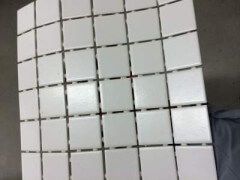Whether you are a contractor or a home owner, chosing the right tiling tools to rent for the job you’re doing always brings up some questions.
The increasingly wide range of materials available in the market don’t help you in this task. The major big box stores carry in their tool rental department a diversity of ceramics products for flooring and wall covering. Nowadays we can really find anything, from hard porcelain and large format tiles to mixed mosaic composed of small tiles of marble, metal, glass and other technical materials. Cutting these new materials properly is not simple. Very often, before reaching the desired result, many tiles are damaged in trying, which means spending extra money to replace them and/or laying the partially damaged tiles in less visible areas of the floor or wall.
In this article we will talk about:
– how to choose the appropriate tile cutter depending on the type of material you’re dealing with (size is vital: you don’t want neither a cutter that is too small nor one that is oversized)
– which accessories you should rent as soon as you start the job
– what to pay attention to when you rent a manual or electric tile cutter from a tool and equipment rental business
– how to properly use the rented or purchased tile cutter on the main products found in big box stores (videos, tricks for cutting specific materials, etc.)
We believe that these tips will help you save your time and money on equipment and tiles, speed up your installation process and have a good final result.
Let’s start with the type of tile cutter to rent or buy.
WHICH TILE CUTTER DO I NEED?
A) If you are dealing with ceramic tiles for wall covering or small porcelain gres tiles (30x30cm with 7mm thickness approximately), glass mosaic or porcelain mosaic with 2x2cm tiles and over, you simply need a strong tile cutter such as the good quality affordable manual snap tile cutters Minimontolit or Minipiuma

B) If you need to cut large porcelain tiles (say, from 40x40cm and over with thicknesses from 7mm up to 12mm) or glass mosaic/stoneware, it is advisable to rent a professional multifunctional tile cutter, powerful enough for you to easily cut these technical materials. If we talk about Montolit, the suggested product is the manual professional tile cutter Masterpiuma.

Accessories you should get along with the cutter:
For all types of tile cutters mentioned above, it’s suggested to buy an accessory that makes it easy and fast to cut almost all types of mosaic without using water. This accessory is the RUBBER MOSAIC PAD ART. 58

What you should pay attention to when buying or renting a tile cutter.
Once you have chosen the tool that suits you, and before you buy it or rent it out, make sure that the cutting wheel is in good conditions and makes proper incisions. To check this, feel the incision “blade” by turning it very slowly and make sure it doesn’t have discontinuities or small lumps or damages along the perimeter.

We’re using the term “blade” here, but rest assured that testing a tile cutter incision wheel by feeling it doesn’t represent a risk of getting cut. Consider that the scoring wheel of a manual tile cutter is designed to make incisions, not to cut. Technically speaking, if the blade was too sharp, it wouldn’t offer good performances and would soon get damaged (becoming unusable) after only a few incisions. Unfortunately, many low-cost-low-quality manual tile cutters have sharp blades that become unusable shortly after you start cutting tiles with them.
If you’re dealing with large format tiles (LFT) or you are cutting strip tiles for skirting boards, consider renting or buying the Baseboard reference system. It gives bracket precision for this type of tile cuts and is suitable for use on all types of cutters. Click here for a video demonstration of the Baseboard accessory for manual tile cutter.
Make sure that the structure of the cutter is solid, that it doesn’t have loose nuts and that the bar on which the wheel carrier flows is straight.
If possible, request a tile cutter test on the materials you are going to install, to make sure it works properly. If you can/want to go even further, do this test yourself.
The pictures below depict some of the most recent ceramics materials that some DIY big box stores are currently selling.
Next to the photo of each material you will find specific notes and tips regarding ceramics materials, videos on the appropriate cutting technique and articles that might help you during installation.
CERAMICS FOR WALL COVERING
CLICK HERE TO FIND OUT HOW TO CUT GLAZED CERAMICS CORRECTLY

PORCELAIN TILES
CLICK HERE TO FIND OUT HOW TO CUT PORCELAIN CORRECTLY

CERAMICS / PORCELAIN MOSAIC
CLICK HERE TO FIND OUT HOW TO CUT MOSAIC CORRECTLY

GLASS MOSAIC AND TILES
CLICK HERE TO FIND OUT HOW TO CUT GLASS MOSAIC AND GLASS TILES CORRECTLY

MIXED MOSAIC (PORCELAIN GRES-GLASS-METAL-MARBLE)
CLICK HERE TO FIND OUT HOW TO CUT MULTIMATERIAL MOSAIC CORRECTLY
WARNING! For cutting mosaic with marble, granite and metal, you will need an electrical cutter with water and specific diamond blade

MARBLE AND / OR GRANITE MOSAIC
CLICK HERE TO FIND OUT HOW TO CUT MARBLE AND / OR GRANITE MOSAIC CORRECTLY
WARNING! In this case, it is highly recommended to use a water cooled electrical tile cutter









